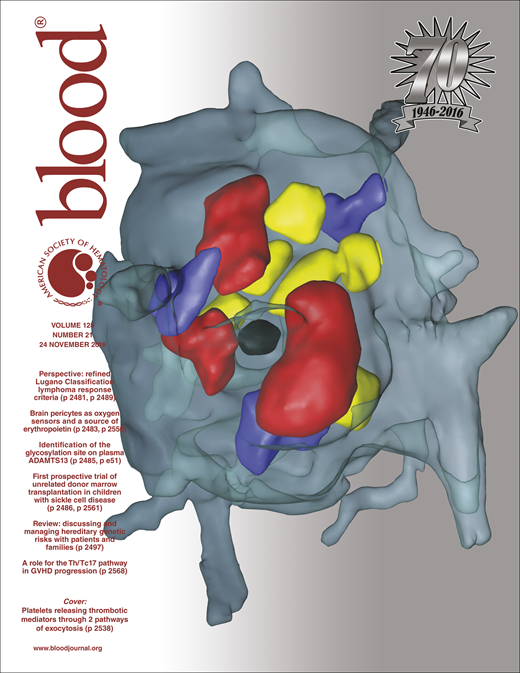In this issue of Blood, Cheson et al tackle the challenge of determining whether immune modulatory anti-lymphoma treatment is working when imaging studies are confusing. 1
Determination of the quality, amount, and duration of response to treatment is crucial to many aspects of the management of lymphoid cancer. Improvement of symptoms, recovery of damaged organ function, and, ultimately, cure require that the amount of the cancer be diminished. New treatments can only be found clinically useful if we unequivocally demonstrate that they reduce the overall tumor burden. Thus, formal response criteria are essential for new drug development and informed patient care. Clinical trials can only be interpreted if we agree on a common language describing response.
The first internationally accepted response criteria for non-Hodgkin lymphoma were published in 1999 by an International Working Group chaired by Bruce Cheson.2 These criteria separated responses into a range from complete response to progressive disease based on physical examination, computed tomography (CT), gallium scanning, and directed biopsies of tumor and bone marrow. These criteria were generally quite adequate for assessment of the available therapeutic agents—predominantly traditional cytotoxic chemicals and external beam irradiation—and quantified the extent of response by measurement of the surface area of visualized tumor masses expressed as the sum of the perpendicular diameters of measurable lesions (SPD). Two fundamental changes forced reconsideration of these original response criteria: the development of functional imaging (fluorodeoxyglucose positron emission tomography [PET])3 and the discovery of therapeutic agents that manipulate the immune system, both passively (monoclonal antibodies, radio-immunoconjugates and antibody-drug conjugates) and actively (immunomodulatory agents; eg, lenalidomide),4 B-cell receptor pathway blockers (eg, BTK and PI3K inhibitors),5-7 and immune checkpoint inhibitors (eg, anti-PD1 agents like nivolumab and pembrolizumab).8 In 2007 and 2014, additional international working groups addressed integration PET imaging9,10 by focusing on the use of PET to assess residual masses visible on computed tomography scanning, allowing us to eliminate the complete response unconfirmed category and much more accurately separate complete response and partial response. The novel therapeutic agents that manipulate the immune system present the newest challenge to accurate response assessment and are the focus of “Refinement of the Lugano Classification lymphoma response criteria in the era of immunomodulatory therapy” in this issue of Blood.1
The initial signals that these new immunotherapeutic agents would require adjustment of response criteria came with the observations that agents such as lenalidomide, rituximab, and B-cell receptor pathway inhibitors can be associated with a temporary rise in lymphocyte count, expansion of tumor masses, or increase in tumor markers such as the IgM level, which presumably result from shifts in malignant cells from one compartment to another (eg, lymph node to peripheral blood); infiltration of tumor masses by inflammatory cells; and release of intracellular contents into the general circulation. Fortunately, such pseudoprogressions usually do not lead to symptomatic worsening and resolve over moderate time periods. Mandatory timed interval reassessment and repeat biopsies, as incorporated in the revised9 and Lugano10 modifications of the original lymphoma response criteria, provide the guidance needed to interpret response correctly. However, as is well described in the paper by Cheson et al, the so-called “immune checkpoint inhibitors,” which act by blocking the activity of immune signaling molecules such as PD-1, PDL-1, and CTLA,8 make response assessment much more problematic.
The difficulty the checkpoint inhibitors pose is rooted in their mode of action—the release of immune effector cells from inhibition induced by the malignant cells. Such effector cells are capable of massive cell destruction, which may in turn induce local tumor swelling, flushing, pain, warmth, and redness, and can be associated with fever, chills, anorexia, malaise, and reduced performance status. Complicating the situation and potentially dangerous for the patient, the reenergized immune effector cells may mistakenly attack normal tissue, stirring up autoimmune toxicity and causing changes to both standard CT and functional imaging.
The proposed remedy to the response assessment confusion associated with the checkpoint inhibitors and, to a lesser extent, immune modulators in general, is a new approach using the lymphoma response to immunomodulatory therapy criteria (LYRIC) and a new response category, Indeterminate Response (IR).1 The IR category can be applied in one or more situations1 : ≥50% increase in SPD without clinical deterioration2 ; appearance of new lesions or increase in size (≥50% PD) of one or more lesions not sufficient to meet criterion 13 ; and increase of PET uptake in ≥1 lesion. Crucial to the correct use of the IR category is the ancillary use of additional biopsies and mandatory reimaging after 12 weeks. Also, at the time of next reimaging, one must compare the images obtained at the time of initial IR1 with those obtained 12 weeks later. Further “progression” exceeding a 10% increase in SPD documents indicates genuine progressive disease. This use of LYRIC is considered provisional and will obviously need reassessment as more experience is acquired.
Will this new response assessment process work? Will it provide accurate evaluation of new therapeutic agents? Will it be safe for patients to continue treatment with agents that would have been stopped using traditional response criteria? Will regulatory agencies accept response assessments based on criteria including the new category IR? These major questions will only be answered if the research community applies these new criteria with consistency and the observed results are widely shared and constructively criticized. Particularly challenging will be the necessity to avoid the mistake of considering a new agent ineffective while at the same time protecting patients from continuing to be exposed to worsening toxicity because off-target tissue injury is erroneously considered nonspecific. It is imperative that we all remember the provisional nature of these proposed changes and actively participate in their refinement. Our research community is indebted to Cheson and his coauthors for their willingness to tackle these challenging questions and to provide us with a workable set of guidelines to improve and validate lymphoid cancer response assessment.
Conflict-of-interest disclosure: The author declares no competing financial interests.

